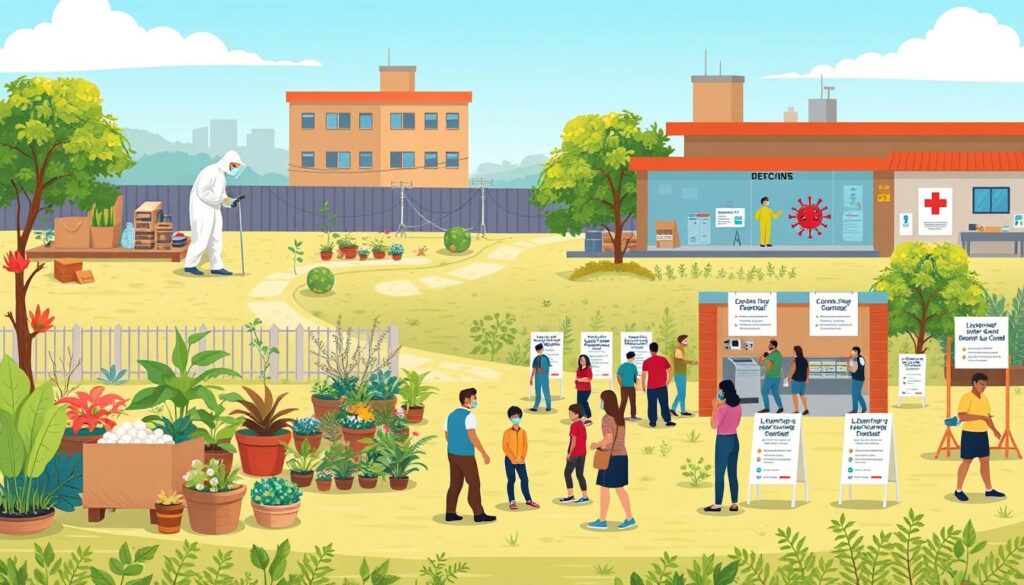The first death from H5N1 in the U.S. has started a big talk about a new pandemic. This happened in someone over 65 with health problems. It’s a big deal in the fight against bird flu.
The H5N1 virus started in Southern China in 1996. It mainly hits birds but has also infected people. By 2024, the U.S. had 66 confirmed H5N1 cases, mostly in farm workers.
People are worried, but health experts say it’s not spreading from person to person. This is like the early days of COVID-19. Experts are looking closely at the health situation and bird flu risks.
Key Takeaways
- The first death from H5N1 in the U.S. has raised concerns over the potential for a new pandemic.
- Since 2024, there have been 66 confirmed human cases of H5N1 in the U.S.
- H5N1 mainly affects farm workers who are close to sick birds and animals.
- No evidence of person-to-person transmission has been found for H5N1 to date.
- The global case fatality rate for H5N1 is about 52%, making health experts very careful.
- The situation needs close watching as experts figure out risks and how to prevent them.
Understanding Avian Influenza and H5N1 Virus
Avian influenza is a group of viruses that mainly hit birds. Some strains are mild, but H5N1 is very bad and kills many birds. Knowing the difference between strains helps us understand the dangers of bird flu.
What is Avian Influenza?
Also called bird flu, it’s caused by influenza A viruses. These viruses are split into two main types: low pathogenic (LPAI) and high pathogenic (HPAI). H5N1 is the high pathogenic type.
This strain has killed many birds, hurting the poultry business a lot. Since 2022, over 100 million birds have died in the U.S. because of bird flu. The virus has also infected mammals, making people worried about health worldwide.
The H5N1 Virus: Characteristics and History
The H5N1 virus was first found in 1996. It has caused big problems all over the world. People who get very sick from H5N1 have a 50% chance of dying.
In the U.S., 66 people have gotten sick from it. Many of these cases were in farm workers who touched infected cows. In November 2023, the virus was found in blue-winged teal in Wisconsin, showing we still need to watch for it.
The virus has hit many species, but not in Australia or some Pacific islands. Scientists are watching how it changes in mammals. They think it could get worse. But, they don’t think it’s a big risk to most people yet.
They want to test people like they do for SARS-CoV-2 to catch it early. This could help stop it from spreading.
The Significance of the First H5N1 Death in the US
The first death from H5N1 in the US is a big deal. It shows we still face big health risks. This case tells us to stay alert and work hard to stop these diseases.
Details of the Case and Patient Background
In December 2023, a person over 65 in Louisiana died from H5N1. They had health problems and got sick from birds. This case is a warning about H5N1’s danger to people.
Implications of the First Death
This death is a big wake-up call for health experts. It shows we need to be ready for avian flu. We must watch for outbreaks and teach people about safety around birds.
| Statistics Related to H5N1 | Data |
|---|---|
| First Recorded Death in US | December 2023, Louisiana |
| Total Human Cases in 2024 | 66 (mostly mild) |
| Bird Infections Since 2022 | 130 million+ |
| Confirmed Human Infections (2023) | 66 cases |
| High-Risk Exposure | 40 to dairy cows, 23 to poultry |
| Global Human Cases Since 2003 | 850+, with 50% fatality rate |
| Average Cost of Eggs (November) | $3.65 |
Is Bird Flu the Next Pandemic? What to Know After the First H5N1 Death in the US
H5N1 bird flu worries are growing. It was first found in China in 1996. Since then, it has caused many human cases, mostly in Asia and Africa.
Over 950 people have gotten sick, and many have died. This makes us all worry about how to stop it.
Historical Context of H5N1 Infections
Since 2021, H5N1 has spread fast. It has hit over 48 species in 26 countries. In the US, it has affected more than 130 million birds.
Also, over 900 dairy farms in 16 states have tested positive. This makes health officials very worried.
The Global Spread of H5N1 and its Effects
H5N1’s spread is causing big problems. It has infected 66 people in 10 states. Most got sick from birds or cattle.
Symptoms include eye problems, breathing issues, and fever. The CDC says the risk is low, but it’s still a big worry.
More animals getting sick means more people could get sick too. This makes it very important to watch and study it closely.

Current State of H5N1 Infections in the United States
The U.S. is watching H5N1 infections closely. Since 2024, 66 people have gotten sick. Most cases came from farms, showing how important it is to know about the virus and animals.
Recent Statistics and Human Cases
Looking at recent numbers helps us understand H5N1’s impact:
- Total wild birds detected: 10,948 as of January 7, 2025
- Jurisdictions affected by bird flu in wild birds: 51
- Poultry affected: 133,470,114 as of January 8, 2024
- Outbreaks in poultry across all 50 states
- Dairy herds affected: 919 as of January 7, 2024
- States with outbreaks in dairy cows: 16
- Human cases related to wild birds: 40
- Human cases related to poultry flocks: 23
- Probable cases linked to commercial poultry in Washington: 3
- Current public health risk categorized as low by the CDC
This data shows a big outbreak. We need to keep watching both people and birds.
Monitoring and Surveillance Efforts
The CDC and state health departments are working hard. They focus on people who work with animals. Finding cases early and tracing contacts helps stop the virus.
No cases of the virus spreading from person to person have been found. But, being near sick birds or cows is risky. We must stay alert to keep everyone safe.
Transmission and Risk Factors for Human Infection
H5N1 virus spreads from animals to humans in ways we need to know. Knowing how it spreads helps us stop outbreaks. It’s important to find out who is most at risk.
How H5N1 is Spread from Animals to Humans
H5N1 mainly spreads when we touch infected birds or their places. People who work with birds or dairy animals are at high risk. The virus can also spread through the air or touching things that birds have touched.
Health experts say we should avoid touching sick animals. They also tell us to wear protective gear in places where birds are kept.
Identifying At-Risk Populations and Environments
Some groups are more likely to get H5N1. These include:
- Poultry workers
- Veterinary services personnel
- Individuals handling dairy animals
- Poultry farm workers and operators of backyard bird flocks
The CDC says places where H5N1 is found are high-risk. They tell us to watch for signs of illness for ten days after being near it. Even though some people have gotten sick, the risk in the U.S. is still low.
The CDC says we need to be careful in places where H5N1 might be. This helps keep everyone safe.
| At-Risk Group | Risk Factors | Suggested Precautions |
|---|---|---|
| Poultry workers | Direct contact with birds | Use of PPE, minimize exposure |
| Veterinary personnel | Handling infected animals | Follow health protocols, vaccination |
| Dairy farm workers | Proximity to infected livestock | Monitor for symptoms, hygiene practices |
| Backyard flock owners | Contact with wild birds | Quarantine sick birds, limit outside access |
Prevention Measures for Bird Flu
To fight bird flu, like H5N1, we need good prevention steps. Health experts say it’s key to follow safe practices for people and animals.
Public Health Recommendations
There are important steps to stop H5N1 from spreading. These include:
- Avoid touching sick or dead birds to lower infection risk.
- Keep up with local bird flu news.
- Check animals’ health often.
- Listen to advice on handling raw products from sick animals.
Safe Handling Practices for Poultry and Dairy
It’s vital to handle poultry and dairy safely. Good practices are:
- Wear the right protective clothes when working with birds or raw milk.
- Cook all poultry well to kill viruses.
- Don’t drink raw milk to stay safe.
The CDC says pasteurization kills the virus in dairy. Knowing and following these rules helps keep us safe around animals that might be sick.
Bird Flu Symptoms and Diagnosis
It’s important to know the bird flu symptoms early. This helps in managing H5N1 infections. Symptoms are like common colds, so it’s key to understand them. Testing and diagnosis have improved to act fast when needed.
Common Symptoms of H5N1 Infection
H5N1 symptoms are similar to the flu or colds. Look out for:
- Fever
- Severe cough
- Red and irritated eyes
- Sore throat
- Muscle aches
- Difficulty breathing
Studies show that eye irritation is common. This is true for people who work with sick birds.
Testing and Diagnosis Protocols
Tests are for those who’ve been near sick animals. The CDC has made testing easier in hospitals. This helps diagnose and treat quickly. The steps include:
- Checking if the person was near sick birds.
- Lab tests to find the virus.
- Watching how the virus changes and affects people.
Knowing symptoms and how tests work is key. It helps fight bird flu outbreaks. Making these steps faster helps keep everyone safe.
| Symptom | Commonality | Notes |
|---|---|---|
| Fever | High | Often the first sign of infection |
| Cough | High | Can escalate in severity |
| Conjunctivitis | Moderate | More common in farm workers |
| Sore Throat | Moderate | Often accompanies cough and fever |
| Muscle Aches | Low | Less specific to bird flu |
| Difficulty Breathing | Low | Urgent care required in severe cases |
Conclusion
The first H5N1 death in the United States is a big worry. It shows we need to keep watching bird flu closely. So far, over 66 people have gotten sick from it in 2024.
Experts say the risk is still low, but we must be careful. This virus is very deadly, which makes us work harder to stay safe. We need to watch closely and teach people about it.
H5N1 is scary, but we can stop it if we try. So far, it hasn’t spread from person to person. But, we must be ready for anything.
Working together is key to fight bird flu. We need to make more vaccines and teach people how to stay safe. As H5N1 changes, we must be ready to face it.


